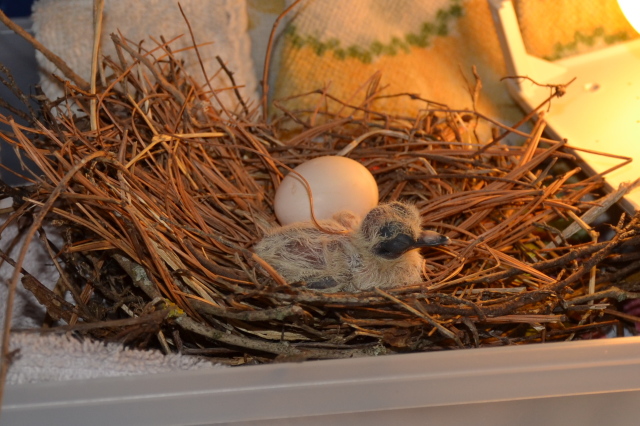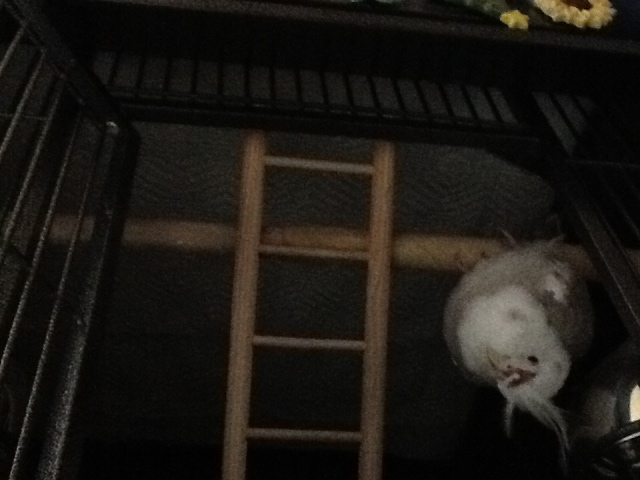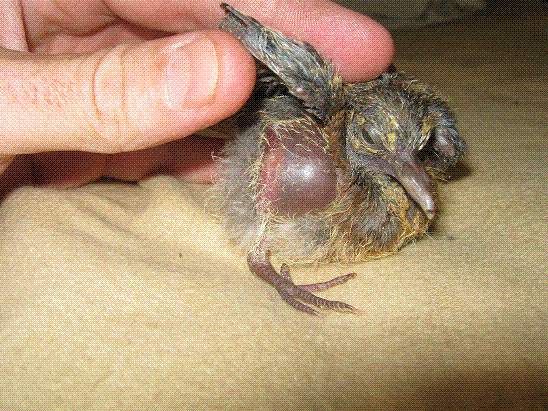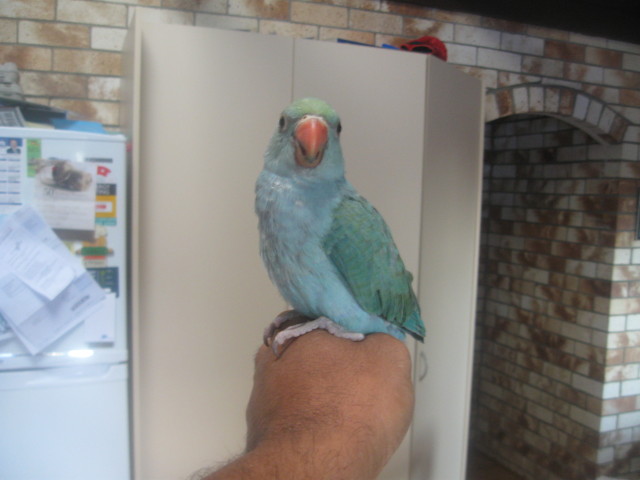QuestionQUESTION: Hello Chrys!
My name is Suellen and I have 2 Cockatiels (Casper and Sahara). I have had them in the same cage together for a while now and I have a couple of questions please :-)
The first one is, can you tell me an accurate way to tell whether I have boy or girl birds? This may be a very common question, but the reason I am asking is related to my second question... I have had them together for several months in a large cage and over the last few weeks, Sahara (who I am thinking is a boy, he's a pearl) has been going up to Casper (who I am thinking is a girl, she's a gorgeous little grey bird) and pulling all the feathers out of the back of her neck. Her tail feathers are all chewed on the ends too. Even though Sahara is quite tame and doesn't mind being held and let out to fly, he chews a lot and also nibbles at my fingernails a lot.
Maybe they might be 2 girls or 2 boys and Sahara is trying to "be boss"???
I have seperated them for the last 2 or so weeks and Casper has all her feathers back now, but upon putting them together again, he started pulling her feathers again. Can you give me any idea why this is happening?
I am told a few things on how to tell boys and girls....the girls can have lighter cheek colours and stripes under their tails, whereas the boys have redder, darker cheeks and no stripes. Is this true, or would my vet be more accurate??
Thanks for your help and your time, I look forward to hearing from you soon,
Kind regards,
Suellen.
ANSWER: Me again! I would also need to know how old they are. If less than 1 year old, the pearl may color out differently with a second molt.
Chrys
-----------------------------
Hi, Suellen,
Sexing your tiels accurately by visual means depends on what color mutation they are. All pearl tiels are females. Normal grey tiels...the male's cheek patch is much brighter than a females. A female's patch is washed out orange. A grey male's tail underside will be solid color. Male tiels are usually fairly vocal and have a beautiful song, whereas females chirp, but don't usually vocalize very well (and don't sing like a male does). Watch their behavior together to help you determine sex. Otherwise, you can DNA sex them for 100% accuracy for about $20 per bird. Visit Zoogen or Avian Biotech on the WWW for more information.
What your birds are likely doing is preening each other. One may be overpreening the other, which is why the bird is missing feathers. Behind the head/neck is a common preening area which often results in baldness in tiels. Messy tail feathers can be the result of too small a cage where the ends of the tail feathers sweep across cage wire or toys, etc. This is more likely the problem with the ends of the tail feathers, particularly if your birds are playful. The tail feathers seem to take the brunt of active tiels!
You may have 2 females. I'd need to see a picture of them to better judge or have more detailed identifying information from you, including details on their behavior.
Chrys
---------- FOLLOW-UP ----------
QUESTION: Hello again Chrys,
Thank you so much for such a great detaied answer!!
I think little Casper, who I suspected was a girl all along, is probably around a year old or so, she's gorgeous and so meek and mild, realy tame. Sahara, who also seems to be a girl according to your answer, is much more vocal and active. She is a little younger, maybe under a year. She doesnt' 'sing' (I will tell you why I know in a moment) but she is really vocal and 'talks' to the birds outside and also my budgies :-) Is there a special way you can get them to actually talk??
The thing is, if I put them back together, I was worried about Casper's feathers all going and that she would end up bald!!! The poor little thing was squalking a bit when I would even touch the back of her neck! She's so mild and sweet, never bites, and I wouldn't want to jeopardise that. Any ideas? I do however let them out together for a fly every day and they sit together. They put their heads together really cute and preen each other, but Sahara is a little more rough, like you predicted.
The reason I know Casper doesn't 'sing' is because at the time I got Casper, I also got another cockateil for my Mum, his name is Monte...now he SINGS!! He makes so many gorgeous sounds it's incredible!! He makes a sound like he's laughing and he's so active. He's beautiful. He was really vicious when we first got him and would draw blood, but we perservered with him and he's pretty tame now, although sometimes he can bite if he wants to! Do you have any ideas on how to stop this?
I would love to send some photos, how do I do this? I have taken them with my mobile phone and they aren't 100% clear, but you can see them well. They are pics of Casper and Monte, I don't have any of Sahara yet :-(
Thank you so much once again for all your help, you certainly know your stuff! I look forward to hearing again from you!
Kind regards,
Suellen.
AnswerHi again, Suellen,
Sahara could still be a boy if s/he hasn't molted for the second time, which usually occurs around 12 months of age. A pearl tiel can have the white lacing when young, but when the second molt occurs and the new feathers grow in, if the white lacing is gone, the bird would be a male. If the white lacing remains after the second molt, the bird is female. Since Sahara is very vocal, perhaps s/he will molt out to be a male. Every tiel is different. Some males are more vocal than other males, and some females chirp more than other females. There are no guarantees when it comes to this in tiels.
Parrots don't actually talk, they mimic sounds they hear. All birds have the ability to talk, but some just choose not to, some choose to mimic. Repetition is key to teaching a bird to mimic. Just keep repeating over and over what you want your male tiels to say or sing or whistle. Try playing the Andy Griffith song over and over...this seems to be a song that is popular with tiels that like to talk!
Regarding preening, this is perfectly normal for birds to do to themselves and each other. In fact, it's a necessity. When birds feathers are growing in, they are wrapped around a keratin sheath, which itches. They preen/others preen this keratin sheath which parrots really enjoy. So the preening isn't a bad thing, however, sometimes the one being preened ends up with a lack of feathers in particular areas. You have 2 choices, keep them separated like you now have them allowing them out-of-cage time together or you can put them back together and put up with Casper not having feathers in certain areas. You could try Bitter Apple or one of these products that tastes badly. You'd spray it on Casper in hopes that Sahara won't overpreen her. I think what might hurt Casper when you touch the back of her neck is the pin feathers coming in....they are sometimes sensitive to a bird.
Biting is a learned behavior in caged birds. This bird has learned that biting gets him what he wants. Therefore, whenever he doesn't want to do what you want him to do, he bites. You have to let this bird know that biting doesn't work with you. For example, if the bird bites you when you try to put him back in his cage, don't let the biting stop you from doing what you need to do. Put your hand right back up there and demand the bird get on your finger so he can be put away. You have to set the boundaries with your birds; don't let them set the boundaries for you.
To send photos, you would have to download them to a website of your choosing and then provide me with the website address. You can also download them and send to me at: chrys.meatyard@wpafb.af.mil. You would attach the photos to an E-Mail.
Chrys

 mourning dove
Question
baby mourning dove
Hello,
My boys found a baby
mourning dove
Question
baby mourning dove
Hello,
My boys found a baby
 White faced cockatiel injury
Question
cockatiel injury
My 8 year old cockatie
White faced cockatiel injury
Question
cockatiel injury
My 8 year old cockatie
 Baby Pigeon
Question
Cosmo
Hi Roger
We picked up a baby pigeon, ap
Baby Pigeon
Question
Cosmo
Hi Roger
We picked up a baby pigeon, ap
 Color of my indian ringneck
Question
Boots
I have an eleven week old male ringneck
Color of my indian ringneck
Question
Boots
I have an eleven week old male ringneck
 Eggs! :(
QuestionBroken Egg
QUESTION: I understand lovebi
Eggs! :(
QuestionBroken Egg
QUESTION: I understand lovebi